The present article is a logical continuation of the previous article concerning the French Regulatory revolver mle 1892. You can find the first article here: Revolver MAS mle 1892, gunsmith work and evolution of the context.
This article is based on a rumor (not entirely false) that the 8mm ammunition used by the 1892 revolver is too weak. The decommissioning of this weapon would be due to the caliber employed. Another element triggering the writing of this article is the rediscovery of a comparison between the ammunition of handguns used by France during the Great War (The document is reproduced below).
This article will detail ballistics data for the 8 mm 1892 (8 mm Lebel) and 7,65 Browning (32 acp) calibres. I will draw from the comparison of these data my conclusions on the decommissioning of the MAS mle 1892 revolver.
The 8 mm French cartridge 1892
To help me in my thinking, I will use a table from a Fiocchi catalog that is very interesting in more ways than one. Here it is :
In my opinion, this table is very useful because it gives for the same modern encartoucheur ballistic elements of several calibres of time. It is therefore very easy to compare and debate around the choices made by the various staffs and governments of the time. While bearing in mind that we do not speak of ammunition era but reproduction respecting all or part of the characteristics of origins.
The data provided by the Italian manufacturer Fiocchi (see the table above) indicates that for a bullet weight of 7.2 grams or 111 grains and a muzzle velocity of 260 m / s. The energy of the warhead to the mouth is 245 joules.
By comparing the energy with the mouth of several regulatory calibres we realize that the 8 mm 1892 is one of the weakest of the time. The reason is due to the speed of the projectile. The 8mm Steyr has a much higher energy with a very close ball weight: 7.3 grams or 113 grains and a mouth speed of 330 m / s. The energy from the nose to the mouth is 395 joules. The average maximum pressure of a cartridge in 8 mm Steyr is: 2300 bar (CIP). The average test pressure of an 8 mm Steyr cartridge is: 2990 bar (CIP). These same data for the 8 mm 1892 are: 1200 and 1560.
One of the peaks is reached by the cartridge 7.63 Mauser, which, by propelling an 88-grain warhead at 440 m / s at an energy of 550 joules (very close to the 9 x 19 cartridge: about 600 joules). The average maximum pressure of a cartridge in 7.63 Mauser is: 2600 bar (CIP). The average test pressure of a 7.63 Mauser cartridge is 3380 bar (CIP).
In their book on Star and Ruby pistols, the authors produce a ballistic table of the French munitions of the Great War and thus compare the 8 mm 1892 and the 7.65 mm Browning. The energy of the warheads is identical and is expressed in kgm: 19 kgm, ie: 186 joules. Even less than the figure announced by Fiocchi in its catalog.
The energy is the same for a 7.65 Browning and a 8 mm 1892. How can we say that the weakness of the ammunition 8 mm 1892 has downgraded the revolver while its replacement transmits the same energy. Is it really the caliber alone that participated in the decommissioning of the weapon ?
Characteristics of the 8 mm 1892:
- Maximum bullet’s diameter (CIP): 8,28 mm ;
- Diameter in the hollow of the stripes (CIP): 8,30 mm ;
- Diameter on the top of the stripes (CIP): 8 mm ;
- Twist (CIP): 1/240 mm ;
- Maximum case length (CIP): 27,4 mm ;
- Cartridge’s length (CIP): 37 mm ;
- Bullet’s mass (Fiocchi): 7,2 g ;
- Bullet’s mass (book : Star and Ruby): 7,85 g ;
- Initial speed (Fiocchi): 260 m / s ;
- Initial speed (book : Star and Ruby): 220 m / s ;
- Initial energy (Fiocchi): about 245 Joules ;
- Initial Energy (book: Star and Ruby): 186 Joules approx ;
- Average maximum pressure (CIP): 1200 bar ;
- Test pressure (CIP): 1560 bar.
The cartridge of 8 mm mle 1892 is a munition with bead therefore usable only in revolver.
It was eight years after the adoption of the MAS mle 1892 revolver and its 8 mm cartridge that the Browning 1900 pistol and its 7.65 Browning cartridge appeared on the market. It will flow from this novelty a whole series of pistols of simple design and similar power of arrest.
The 7.65 browning / 32 acp cartridge
Introduced in 1899 by the FN for use in its 1900 automatic pistol. The 7.65 Browning cartridge will shake up the market for handguns. This low pressure cartridge will allow the manufacture of automatic pistol reliable and simple because without locking system. The absence of this type of device significantly reduces the number of parts and the complexity thereof. The misdeeds of the anarchists of this period contributed, through their media coverage, to the spread of these new types of handguns. The craze is fast, it’s a popular success.
To study this cartridge, I would help you from another page of the same Fiocchi catalog. There she is :
There are several 7.65 Browning cartridge references on this catalog page. Depending on the type of warhead and the speed of the latter, the indicated energy is 175 to 280 joules. This last value is obtained by the use of a hollow tip warhead at high speed.
The table quoted above from the book Star and Ruby gives the following elements: ball weight: 4.85 grams, bullet speed: 270 m / s, projectile energy: 186 joules.
- Max bullet diameter (CIP): 7.85 mm ;
- Diameter in the hollow of the stripes (CIP): 7.83 mm ;
- Diameter on the top of the stripes (CIP): 7.63 mm;
- Twist (CIP): 1/250 mm ;
- Maximum case length (CIP): 17.2 mm;
- Cartridge length (CIP): 25 mm ;
- Bullet’s weight (book : Star and Ruby): 4.65 grams ;
- Initial speed (book : Star and Ruby): 270 m / s ;
- Initial Energy (book: Star and Ruby) : 186 Joules ;
- Average maximum pressure (CIP): 1800 bar ;
- Test pressure (CIP): 2340 bar.
The 7.65mm Browning case has a very light bead. It is thanks to this bead that the ammunition will be used sometimes in revolver.
Since the energy of the projectile is the same, let’s try to find other lines of thought relating to the decommissioning of the MAS mle 1892 revolver. Below you will see some direct competitors of the MAS mle 1892 revolver.
The Browning 1900 pistol :
Very big commercial success which sold more than 700 000 copies between 1900 and 1912 is about 70 000 manufactured copies a year … nothing but that. We can see through the manufactured volumes that this weapon meets an expectation of the public and administrations. The gun becomes simple, compact, reliable … it is democratized. The quality of manufacture is also responsible for this success. The opportunity was given me in the past to have a Browning 1900 in hand, it is a well designed weapon, well done and very compact. It is obvious that he could only make the revolver obsolete. However, it requires the user to keep a room ammunition and an armed striker.
- mass of the unloaded weapon: 625 g ;
- Total length: 163 mm ;
- Length of the barrel: 102 mm ;
- Weapon capacity: 7 cartridges.
The Browning 1910 pistol :
The Browning 1910 is the successor of the Browning 1900. It is a simpler weapon than its elder. With a perfect design, it will go through the decades without any major changes. A very important feature on this weapon is the safety pedal on the back of the pistol grip. It will be manufactured between 1912 and 1975 to more than 704,000 copies.
- Mass of the weapon in 7.65 mm: approximately 590 g ;
- Total length : 153 cm ;
- Barel length : 88 mm ;
- Capacity of the weapon in 7.65 mm: 7 cartridges.
The FN/COLT 1903 pistol :
- Mass of the weapon in 7.65 mm: approximately 590 g ;
- Total length : 153 cm ;
- Barel length : 88 mm ;
- Capacity of the weapon in 7.65 mm: 7 cartridges.
The Star et Ruby pistol
These weapons will be next to the MAS mle 1892 revolver in the trenches from 1914 to 1918. They are a simplification of the weapons of the major suppliers mentioned above.
France is equipped with these materials to supplement endowments without having to overload the employment of national manufactures. The number of Ruby pistols sold in France is 900,000. The number of Star guns sold to France is 24,000.
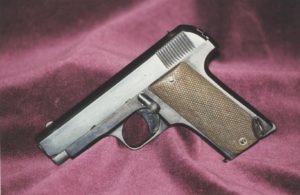
- Mass of the weapon (Ruby pistol): about 875 grams ;
- Total length (Ruby pistol): 157 mm ;
- Barrel length (Ruby pistol): 87 mm ;
- Weapon Capacity (Ruby pistol): 7 to 9 rounds.
Conclusion
By comparing the above elements, we can see that as soon as the Browning 1900 pistol came out (only 8 years after the adoption of the revolver), this automatic weapon outclasses in some areas the French regulatory weapon of the moment:
- Lighter weapon ;
- Very compact weapon ;
- Simple manufacturing ;
- Irreproachable manufacturing quality ;
- Easy maintenance ;
- Weapon of lesser size ;
- Speed of loading ;
- Upper loader capacity.
It can be noticed that the power of the 7.65 mm ammunition is very close (see identical) to the 8 mm cartridge of 1892. Despite this proximity, the 7.65 Browning caliber will endow many countries and individuals through the world causing the manufacture of millions of weapons. These weapons will equip various government forces until the 1970s or even 1980s. We see that the reproach of power is erased from the advantages brought by the principle of automaticity. It is then possible to place several ammunition on the same objective without fear of its power or the time of reloading the weapon.
The 7.65 Browning automatic pistol has therefore replaced or supplemented in some hearts and for certain uses the MAS mle 1892 revolver or derivatives. However, although its loading requires a longer time and its capacity is lower, we must not forget that the revolver remains master over some portions of the range of uses. The use by the Germans of the MAS mle 1892 revolver on the eastern front during the Second World War demonstrates this.
The rapid evolution of the industrial context at the end of the 19th century and the beginning of the 20th century, the evolution of smokeless powder, steels have allowed a series of good technological advances rendering certain weapons and war techniques obsolete. The saber fight is over. The economy of cartridges too.
A constant demand for modernity and efficiency will lead up the steps of the podium another cartridge of intermediate diameter: the 9 mm luger (whose energy to the mouth is close to 600 joules). But that’s another story.








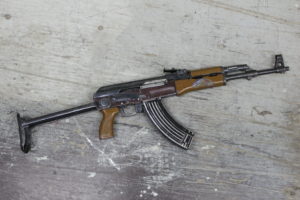

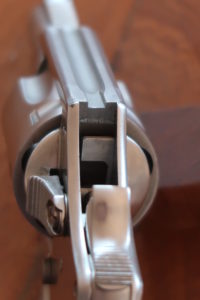
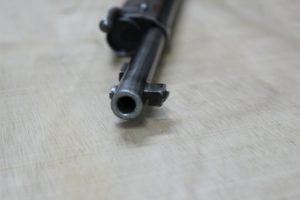

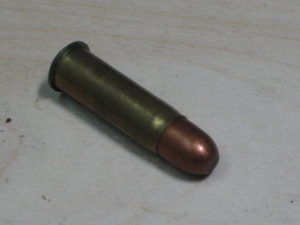
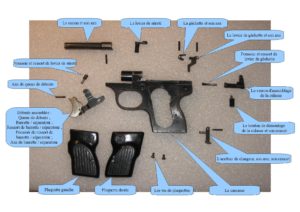
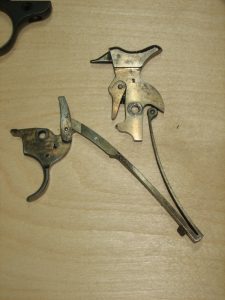

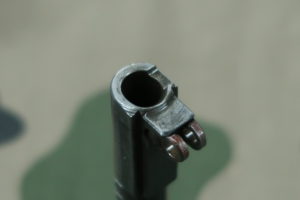
Était-ce la raison réelle ? Les pistolets modernes (modèles 1935A et 1935S) avait 8 cartouches dans leurs chargeur, était moins encombrant, et un prix de production certainement plus faible comparé à celle de très belle qualité du 1892 (idem MR73) ?
D’autre part le basculement à droite du barillet sur le 1892 hérité de ses prédécesseurs (cavalerie avec sabre + arme de poing) n’a pas dû favoriser sa survie, d’autant que la cavalerie s’est motorisée et le sabre plus trop pertinent. Le temps de rechargement d’un révolver comparé à un pistolet avec un chargeur ne lui est pas non plus favorable.
Et puis en face il y avait les pistolets semis automatiques avec des puissances de feu supérieures.
Ça fait beaucoup de choses, sans parler de la poudre noire spéciale….alors que nous avions inventé la poudre sans fumée.